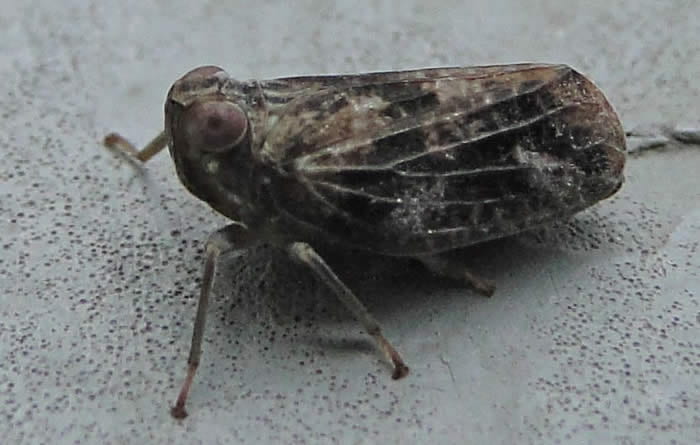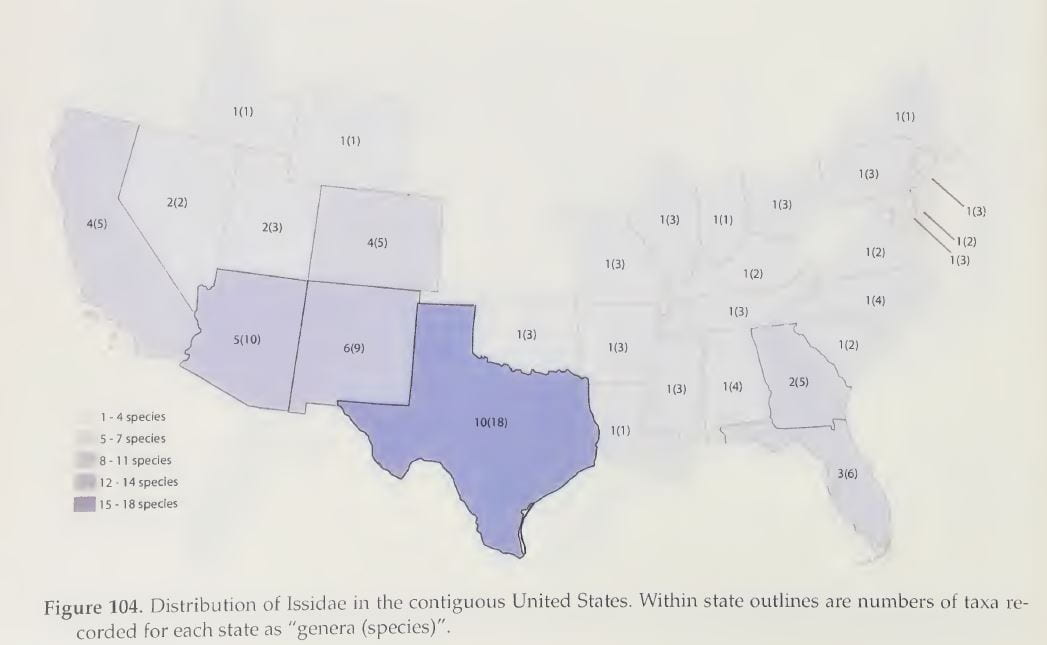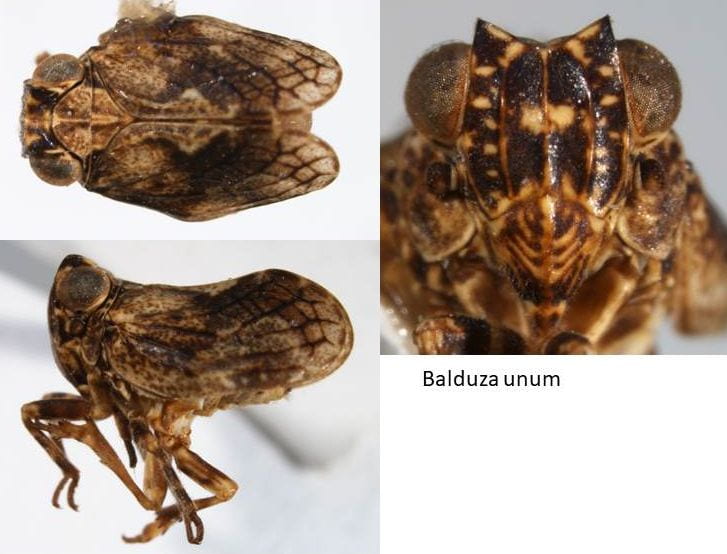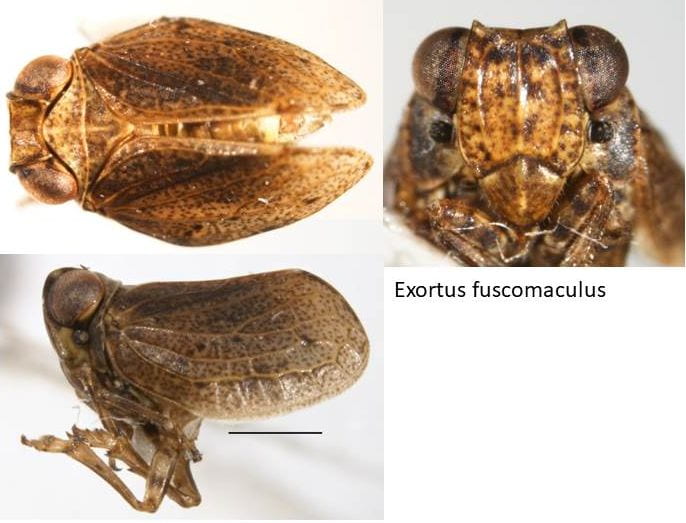Issidae is the 5th largest family of planthoppers, consisting of 193 genera and 1,084 species (Bourgoin 2017; excluding Caliscelidae), and recently an active source of systematic investigation. The higher classification of Issidae has been the subject of recent investigation (and frequent revision). Fennah (1954) revised the classification of Issidae, in which he included Acanaloniidae as a subfamily, and in 1984, removed a series of North American issid genera (Bladinini subtribe Gaetuliina) to Nogodinidae, which subsequently were moved to Tropiduchidae (as tribe Gaetuliini) (Gnezdilov 2007); and then subsumed under the Elicinae (Gnezdilov 2013). Several authors have since provided evidence that Issidae as defined by Fennah (1954, 1984) is not monophyletic (e.g., Emeljanov 1991, Yeh & Yang 1999, Wang et al. 2016). Emeljanov (1999) recognized Caliscelidae as a family, and restored Acanaloniidae to family status (previously subsumed under Issidae by Fennah 1954). Acanaloniidae was defined to include Euthiscia, and 2 Old World subfamilies (Trienopinae and Tonginae), the latter 2 subsequently moved to Nogodinidae and Tropiduchidae (Gnezdilov 2007, 2008). A series of additional changes to the higher taxonomy have been proposed, but for taxa north of Mexico the most important changes are the subtribal definitions proposed by Gnezdilov (2003b, 2009). Recently, Gnezdilov et al. (2014) have provided a checklist of the western Palearctic issid fauna, with keys to genus and photos of all included genera. Wang et al. (2016) has provided a first quantitative phylogenetic treatment of Issidae, placing the Thioniini (as Thioniinae) basal and sister to the remaining Issidae (Thionini had previously been subsumed under Issini) and suggesting that the current definition of Issidae may be too narrow. Wang et al. (2016) also revised the higher classification of Issidae. Some North American Issidae are treated as Subfamily Hemisphaeriinae Melichar, 1906 (incertae sedis) in Wang et al. 2016.
North American issids, as currently defined, can be recognized by the hind tibiae bearing 1-4 lateral spines (Acanaloniidae have none), forewings covering the abdomen and usually not reticulate (if reticulate then uniformly so, without patches of clear cells), and pronotum usually not extending anteriorly beyond the middle of the eyes. Like all higher planthoppers, Issidae have a pair of spines on the second tarsomere of the hind leg.
Issidae north of Mexico consist of 11 genera and 24 species. North American Issidae (including Caliscelidae and Gaetuliini) were revised by Doering (1936, 1938, 1940, 1941, 1958), and these works can be consulted for species identification. O’Brien (1988) provided a revised key to genus based on Doering (1938), later updated by Gnezdilov & O’Brien (2006b). Gnezdilov (2003a, 2004a) noted that North American Hysteropterum are not congeneric with the European species and 5 genera (Abolloptera, Balduza, Exortus, Kathleenum, Stilbometopius) were subsequently erected for North American Hysteropterum (Gnezdilov 2004a, Gnezdilov & O’Brien 2006b). Gnezdilov & O’Brien (2006a) report Hysteropterum severini and H. beameri as synonyms of Agalmatium bilobum (Fieber), a European species. Tylana ustulata was transferred to Hysteropterum by O’Brien (1988), subsequently to Tylanira by Gnezdilov & O’Brien (2006b), who also raised Paralixes from subgenus to genus status out of Ulixes Stål, 1861. Paralixes and Ulixes are rare in collections, and there appear to be undescribed species in these genera, but infraspecific variation is poorly understood.
In the U.S., Issidae is most species rich in the south, with most genera also occurring also in Central America, except the adventive Agalmatium. Thionia as currently defined includes 70 species, a few of which are Old World (Gnezdilov 2018 recently segregated out some Nearctic forms into new genera Thionia simplex into Aplos Gnezdilov, 2018; and 3 species with projected heads into Fowlerium Gnezdilov, 2018). Of the remaining genera, all are limited to North and Central America. The genera Paralixes (total of 4 species), Picumna (10 species) and Traxus (2 species) include Central American species not found in the U.S.
Issidae is usually associated with woody plants both as adults and nymphs, and are found on the above-ground portion of plants. Most species are reported as monophagous (Wilson et al. 1994). Wheeler & Wilson (1987, 1988) describe the life history of Thionia elliptica, T. bullata and T. simplex. Thionia elliptica feeds on Quercus (in Pennsylvania mostly on Quercus ilicifolia Wangenh.), with a single generation per year, adults emerging in July and August, overwintering as eggs (Wheeler & Wilson 1987). Thionia bullata is univoltine on pines (including the introduced Pinus sylvestris L.), overwintering as eggs, with development requiring about 10 weeks (Wheeler & Wilson 1988, Wheeler 1996). Thionia simplex is polyphagous on a variety of herbaceous and woody plants (Wheeler & Wilson 1988). Schlinger (1958) describes the biology of the adventive Agalmatium bilobum (as Hysteropterum beameri) in California, which creates ‘mud cases’ for its eggs (see also Boulard 1987).
The higher taxonomy of Issidae north of Mexico is summarized below. In a continuing collection of papers, Gnezdilov (esp. Gnezdilov 2013a, Gnezdilov et al. 2014) has revised Issidae into a much more limited concept than previously considered (e.g., Fennah 1954); however, Wang et al. (2016) has provided the first substantive molecular phylogeny of Issidae and has provided a considerable rearrangement of taxa, which has resulted in most Nearctic issid genera being moved to Issidae insertae sedis.
Tribe Colpopterini Gnezdilov, 2003b
Colpoptera Burmeister, 1835 (Type species Colpoptera sinuata Burmeister, 1835)
(note: Gnezdilov 2012d has moved this tribe to Nogodinidae, upgraded to subfamily].
Subfamily Issinae Spinola, 1839
Tribe Hysteropterini Melichar, 1906 (was in Issini)
Subtribe Agalmatiina Gnezdilov, 2002
Agalmatium Emeljanov 1971 (Type species Cercopis grylloides Fabricius, 1794; jr. syn. of Fulgora flavescens Olivier, 1791).
Subfamily Thioniinae Melichar, 1906
Tribe Thioniini Melichar, 1906
Aplos Gnezdilov, 2018
Cheiloceps Uhler, 1895 (Type species Cheiloceps musca Uhler, 1895; 8 species, Lesser Antilles, Caribbean), new status (genus, not subgenus of Thionia) by Gnezdilov, 2018.
Fowlerium Gnezdilov, 2018
Picumna Stål 1864 (Type species Picumna varians Stål, 1864).
Thionia Stål 1859 (Type species Issus longipennis Spinola 1839). (subgenus Cheiloceps was raised to a full genus by Gnezdilov, 2018)
Issidae (incertae sedis)
Abolloptera Gnezdilov & O’Brien 2006b (Type species Hysteropterum bistriatum Caldwell, 1945).
Balduza Gnezdilov & O’Brien 2006b (Type species Hysteropterum unum Ball, 1910).
Exortus Gnezdilov 2004 (Type species Hysteropterum punctiferum Walker, 1851).
Kathleenum Gnezdilov 2004 (Type species Hysteropterum cornutum Melichar, 1906).
Paralixes Caldwell 1945 (Type species Issus scutatus Walker, 1851).
Stilbometopius Gnezdilov & O’Brien 2006b (Type species Issus auroreus Uhler, 1876).
Traxus Metcalf 1923 (Type species Traxus fulvus Metcalf, 1923).
Tylanira Ball 1936 (Type species Tylanira bifurca Ball, 1936).
Key to genera of Issidae north of Mexico (From Bartlett et al. 2014, until I fix them, figure references pertain to that work; the new genera Aplos and Fowlerium Gnezdilov, 2018 are not yet included).
Note: Parenthetical numbers following genera in the key refer to the part number and page of Doering’s revision of the Issinae (1936, 1938, 1939, 1941), i.e., 2: 458 refers to part 2 (1938), page 458). Misodema (Tropiduchidae: Elicini [Gaetuliini]) and Colopoptera (Nogodinidae) are included in this key since it is easily mistaken for an issid.
1. Hind wings present, entire, with strongly marked notches at the joints of the folds, anal area large (wings usually visible from ventral view of insect); vein Sc1 absent; larger issids varying from 5.5 to 8.1 mm (Thioniinae & Colpopterinae) 2
1.’ Hind wings absent or rudimentary 4
2. Posterior tibiae with 1 spine; narrow, elongate planthoppers; adventive, Florida; widespread in Mesoamerica, Caribbean and South America (as currently defined) – Colpoptera Burmeister (Nogodinidae)
2.’ Posterior tibiae with 2-4 spines (Figs. 1F-G); broad, stout planthoppers; widespread … 4
3. Posterior tibiae with 2 (or 3) spines (Fig. 1F); cubital vein of forewing simple – Thionia Stål (2: 458) … 3a (interim couplets)
3.’ Posterior tibiae usually with 4 spines (Fig. 1G); cubital vein of forewing branched … Picumna Stål (2: 471)
3a Bulla lacking, intermediate carinae of frons lacking … Aplos Gnezdilov, 2018
3a’ Bulla present, intermediate carinae of frons present … 3b
3b Head pointed in dorsal view, vertex longer than wide … Fowlerium Gnezdilov, 2018
3b’ Head distally truncate in dorsal view, vertex not pointed … Thionia Stal (heterogenious genus)
4. Body broad, almost rounded in dorsal view (Figs. 86G, K); forewings strongly reticulate and parchment-like, held somewhat tectiform … 5
4.’ Body more elongate (Figs. 85F-J, 86I, L, 89H); forewings usually leathery, not reticulate, held more vertically [Hysteropterum sensu Doering 1938 (2: 481)] … 6
5. Mesonotum with lateral carinae elevated on rounded peaks (evident in lateral view; fig 87J); clypeus receding with respect to frons – Traxus Metcalf (2: 449)
5.’ Mesonotum with lateral carinae normal, not elevated; clypeus on same plane as frons (Fig. 87F) – Paralixes Caldwell (2: 452)
6. Intermediate carinae of front (between median and lateral carinae) obsolete, not raised … 7
6.’ Intermediate carinae of front present, raised … 10
7. Forewing strongly reticulate (Fig. 90H); in lateral view, head projecting dorsally, front reclinate … Misodema Melichar (2: 534)
7.’ Forewing not strongly reticulate (Figs. 87A, B, H); head not projecting, frons nearly truncate … 8
8. Frons with longitudinal depression each side of median carina (Fig. 85A); anterior margin of vertex medially projecting, weakly bisinuate laterally (Fig. 85F) – Abolloptera bistriata (Caldwell)
8.’ Frons flat or slightly convex; anterior margin of vertex not medially projecting, nearly truncate (Figs. 85G, 86I) … 9
9. Dorsal margin of frons flat (Fig. 85B); cells in forewings without black dots; adventive in California – Agalmatium bilobum (Fieber)
9.’ Dorsal margin of frons slightly convex; costal border cream colored, other cells in forewing with black dots … Stilbometopius auroreum (Uhler)(2: 482)
10. Vertex deeply emarginate at apex, thus forming lateral triangular projections inclined upward (Figs. 86F, L); frons emarginate at frontoclypeal margin; larger species usually 4.4 mm or over … Tylanira Ball (3: 144)
10.’ Vertex not as above; smaller species usually 4.4 mm or smaller … 11
11. Intermediate carinae of frons parallel or weakly converging dorsally (Fig. 85E); frons at dorsal margin wider than tall at median carina; dorsal margin of frons wider than frons at midline (about 1.25x) with wide straight median line and sides angled upward; vertex about 3x wider than long in middle (Fig, 85J) … Kathleenum Gnezdilov
11.’ Intermediate carinae of frons converging dorsally (Figs. 85C-D); frons at dorsal margin about as wide as tall at median carina (about 1.05x) with dorsal dorsal margin v-shaped; vertex about 2x wider than long in middle (Figs. 85H, I) … 12
12. Forewings uniformly speckled with fine dots, otherwise not strongly patterned (Fig. 87D); dorsoanterior portion of head rounded (not raised) in lateral view; dorsal margin of forewing straight in lateral view; southeastern … Exortus Gnezdilov
12.’ Forewings patterned, irregularly speckled (Fig. 87C); dorsoanterior portion of head raised in lateral view; dorsal margin of forewing concave in lateral view; southwestern … Balduza Gnezdilov
Selected referencesBartlett, C. R., L. B. O’Brien and S. W. Wilson. 2014. A review of the planthoppers (Hemiptera: Fulgoroidea) of the United States. Memoirs of the American Entomological Society 50: 1-287.
Bliven, B. P. 1966. New genera and species of Issidae. Occidental Entomologist 1(9): 103-107.
Boulard, M. 1987. Contribution a l’etude des Issidae. L’ootheque terreuse des ‘Hysteropterum’, un probleme evolutif (Hom. Fulgoroidea). Bulletin de la Societé Entomologique de France 92(1-2): 5-17.
Bourgoin, T. 2017. FLOW (Fulgoromorpha Lists on The Web): a world knowledge base dedicated to Fulgoromorpha. Version 8, updated 14 June 2017. http://hemiptera-databases.org/flow/
Caldwell, J. S. 1945. Notes on Issidae from Mexico (Homoptera: Fulgoroidea). Annals of the Entomological Society of America 38: 89-120.
Caldwell, J. S. and D. M. DeLong. 1948. A new species of Issidae from California (Homoptera: Fulgoroidea). Ohio Journal of Science 48:176-177.
Doering, K. C. 1936. A contribution to the taxonomy of the subfamily Issinae in America north of Mexico (Fulgoroidea: Homoptera. Part I. University of Kansas Science Bulletin 24(17): 421-467.
Doering. K. C. 1938. A contribution to the taxonomy of the subfamily Issinae in America north of Mexico (Fulgoroidea: Homoptera. Part II. University of Kansas Science Bulletin 25(20): 447-575.
Doering. K. C. 1939. A contribution to the taxonomy of the subfamily Issinae in America north of Mexico (Fulgoroidea: Homoptera. Part III. University of Kansas Science Bulletin 26(2): 83-167.
Doering, K. C. 1941. A contribution to the taxonomy of the subfamily Issinae in America north of Mexico (Fulgoroidea: Homoptera. Part IV. University of Kansas Science Bulletin 27(10):185-233.
Doering, K. C. 1958. A new species of Hysteropterum from grape (Issidae, Fulgoroidea, Homoptera). Journal of the Kansas Entomological Society 31: 101-103.
Emeljanov, A. F. 1991. An attempt to construct a phylogenetic tree for planthoppers (Homoptera, Cicadina). Entomological Review 70: 24-28 (Translation of Entomologicheskoye Obozreniye 1990, 69: 353-356, in Russian).
Emeljanov, A. F. 1999. Notes on the delimination of families of the Issidae group with description of a new species of Caliscellidae belonging to a new genus and tribe (Homoptera, Fulgoroidea). Zoosystematica Rossica 8(1): 61-72.
Fennah, R. G. 1954. The Higher classification of the family Issidae (Homoptera: Fulgoroidea) with descriptions of new species. Transactions of the Royal Entomological Society of London 105(19): 455-474.
Fennah, R. G. 1955. Lanternflies of the family Issidae of the Lesser Antilles (Homoptera: Fulgoroidea). Proceedings of the United States Museum 105(3350): 23-47.
Gnezdilov, V. M. 2002. Morphology of the ovipositor in the subfamily Issinae (Homoptera, Cicadina, Issidae). Entomologicheskoe Obozrenie 81(3): 605-626, 780. [In Russian]
Gnezdilov, V. M. 2003a. Review of the family Issidae (Homoptera, Cicadina) of the European fauna, with notes on the structure of ovipositor in planthoppers. Chteniya Pamyati Nikolaya Aleksandrovicha Kholodkovskogo (Meetings in memory of N.A. Cholodkovsky) 56(1): 1-145. [Russian with English summary].
Gnezdilov, V. M. 2003b. A new tribe of the family Issidae with comments on the family as a whole (Homoptera: Cicadina). Zoosystematica Rossica 11(2): 305-309.
Gnezdilov, V. M. 2004a. Two new genera of the family Issidae (Homoptera: Cicadina: Fulgoroidea) from North America. Russian Entomological Journal 13 (1-2): 1-2.
Gnezdilov, V. M. 2004b. Morphology of the ovipositor in members of the subfamily Issinae (Homoptera, Cicadina, Issidae). Entomological Review 82(8): 957-974.
Gnezdilov, V. M. 2009. Revisionary notes on some tropical Issidae and Nogodinidae (Hemiptera: Fulgoroidea). Acta Entomologica Musei Nationalis Pragae 49(1): 75-92.
Gnezdilov, V. M. 2011. A new genus and new species of the family Issidae (Hemiptera, Fulgoroidea) from Venezuela. Deutsche Entomologische Zeitschrift 58(1): 119-121.
Gnezdilov, V. M. 2012d. Revision of the tribe Colpopterini Gnezdilov, 2003 (Homoptera, Fulgoroidea: Nogodinidae). Entomologicheskoe Obozrenie XCI(4): 757-774 [in Russian].
Gnezdilov, V. M. 2013a. Modern classification and the distribution of the family Issidae Spinola (Homoptera, Auchenorrhyncha: Fulgoroidea). Entomologicheskoe Obozrenie 92(4): 724-738.
Gnezdilov, V. M. 2013. Contribution to the taxonomy of the family Tropiduchidae Stål (Hemiptera, Fulgoroidea) with description of two new tribes from Afrotropical Region. Deutsche Entomologische Zeitschrift 60(2): 179-191.
Gnezdilov, V. M. 2016. Notes on the phylogenetic relationships of planthoppers of the family Issidae (Hemiptera, Fulgoroidea) of the Western Palaearctic fauna, with descriptions of two new genera. Entomologicheskoe Obozrenie 95(2): 362-382.
Gnezdilov, V. M. 2018. To the revision of the genus Thionia Stål (Hemiptera, Fulgoroidea, Issidae), with description of new genera and new subtribe. Zootaxa 4434 (1): 158–170. https://doi.org/10.11646/zootaxa.4434.1.10.
Gnezdilov, V. M. and L. B. O’Brien. 2006a. Hysteropterum severini Caldwell and DeLong, 1948, a synonym of Agalmatiumbilobum (Fieber, 1877) (Hemiptera: Fulgoroidea: Issidae). Pan-Pacific Entomologist 82(1): 50-53.
Gnezdilov, V. M. and L. B. O’Brien. 2006b. Generic changes in United States Issini (Hemiptera, Fulgoroidea, Issidae). Insecta Mundi 20(3-4): 217-225.
Gnezdilov, V. M. and L. B. O’Brien. 2008. New taxa and combinations in Neotropical Issidae (Hemiptera: Fulgoroidea). Insecta Mundi 31: 1-26.
Gnezdilov, V. M., W. E. Holzinger and M. R. Wilson. 2014. The western Palaearctic Issidae (Hemiptera, Fulgoroidea): An illustrated checklist and key to genera and subgenera. Proceedings of the Zoological Institute RAS. 318, supplement 1. 118 pp.
O’Brien, L. B. 1988. Taxonomic changes in North American Issidae (Homoptera: Fulgoroidea). Annals of the Entomological Society of America 81(6): 865-869.
Schlinger, E. I. 1958. Notes on the biology of a mud egg-case making fulgorid, Hysteropterum beameri Doering (Homoptera: Fulgoroidea). Journal of the Kansas Entomological Society 31(2): 104-106.
Stroinski, A. and J. Szwedo. 2008. Thionia douglundbergi sp. nov. from the Miocene Dominican amber (Hemiptera: Fulgoromorpha: Issidae) with notes on extinct higher planthoppers. Annales Zoologici 58(3) 529-536.
Wang, M.L., Y.L. Zhang and T. Bourgoin. 2016. Planthopper family Issidae (Insecta: Hemiptera: Fulgoromorpha): Linking molecular phylogeny with classification. Molecular Phylogenetics and Evolution 105:224-234.
Wheeler, A. G., Jr. 1996. Use of an introduced host, scotch pine, by a native planthopper, Thionia bullata (Homoptera: Fulgoroidea: Issidae). Proceedings of the Entomological Society of Washington 98(2): 374-375.
Wheeler, A. G., Jr. and S. W. Wilson. 1987. Life history of the issid planthopper Thionia elliptica (Homoptera: Fulgoroidea) with description of a new Thionia species from Texas. Journal of the New York Entomological Society 95(3): 440-451.
Wheeler, A. G., Jr. and S. W. Wilson. 1988. Notes on the biology and immatures of the issid planthoppers Thionia bullata and T. simplex (Homoptera: Fulgoroidea). Journal of the New York Entomological Society 96(3): 266-273.
Wilson, S. W., C. Mitter, R. F. Denno and M. R. Wilson.1994. Evolutionary patterns of host plant use by delphacid planthoppers and their relatives. In: R. F. Denno and T. J. Perfect, (eds.). Planthoppers: Their Ecology and Management. Chapman and Hall, New York. Pp. 7-45 & Appendix.






